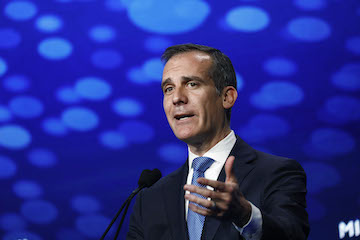Los Angeles Mayor Eric Garcetti is optimistic infrastructure projects in America’s second-biggest city will be big beneficiaries of the sweeping federal infrastructure bill—potentially receiving tens of billions of dollars.
“We’re going to be in a really good place to benefit from it,” Garcetti, 50, said in an interview Friday. “We disproportionately have things like the port, the airport that move the nation’s infrastructure.”

Water, transportation and climate-resilience projects have long been priorities for Garcetti, President Joe Biden’s pick as ambassador to India. But they may play a key role in helping Los Angeles—a city that’s endured worsening homelessness—bounce back from the hit it took during the Covid pandemic as such projects create jobs.
Garcetti was in Washington earlier this week for the signing of the bill, which calls for $550 billion of new infrastructure spending. It will allocate about $110 billion for roads and bridges, plus funds for rail, public transit, the power grid and drinking-water systems. Funds may also help the city speed up the completion of an important water project, he said.
Southern California ports are among the potential beneficiaries of the new funding. Supply-chain bottlenecks have contributed to the snarling of ports in Los Angeles and Long Beach—strains Garcetti and other officials expect to linger at least through mid-2022.
California Governor Gavin Newsom this week said the state will be aggressive in its bid to get funds from the infrastructure bill, demanding for the biggest U.S. state’s “share of investment.” The federal bill designates $17 billion for port infrastructure nationwide.
Although local leaders this week touted a 32% drop in the number of containers sitting on the docks for more than nine days, at least 75 container ships continue to wait for an average of 18 days for a green light to anchor. To tackle these issues, officials have announced plans to operate around the clock and impose extra fees on container ships sitting on the docks for too long, on top of easing restrictions on truck weights and container storage.
Garcetti, who sees an issue with the transportation infrastructure between the warehouses and retail stores than the ports, would like to see further investment in on-dock rail “so we don’t have to depend as much on trucks,” he said. “This is kind of a once-in-a-generation moment that’s the result of a pandemic.”

Follow us on social media: